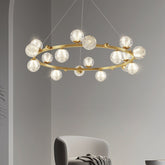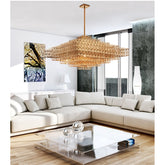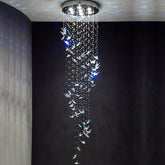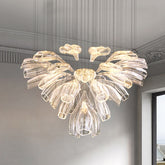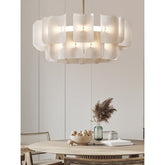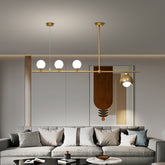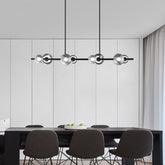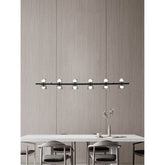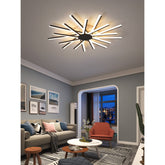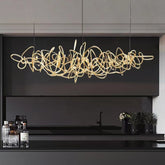Tips for Properly Installing and Maintaining Hanging Lights in Your Home
Hanging lights. Those elegant luminaries suspended from our ceilings, serve as more than just sources of illumination. They're like the jewelry of our homes, adding a touch of glamour and personality to our living spaces. Whether it's casting a warm glow over the dining table during a family meal or providing focused task lighting in the kitchen, hanging lights play a crucial role in both the aesthetics & functionality of our homes.
In this guide, we'll go into the subject of hanging lights, exploring not only their decorative potential but also the nuts and bolts of installing & maintaining them. Because let's face it, while choosing the perfect pendant or chandelier can be exhilarating, ensuring it hangs securely and shines brightly requires a bit of know-how.
Choosing the Right Hanging Lights
So, you've decided it's time to add some flair to your home with hanging lights. But where to begin? Well, let's start with the fun part: picking out the perfect lights to suit your space!
When it comes to choosing hanging lights, it's not just about picking the prettiest fixture you can find (although that's definitely part of it!). You'll also want to consider the specific needs and style of each room in your home.
Think about it like this: just as you wouldn't wear hiking boots to a black-tie event (well, most of us wouldn't!), you shouldn't hang a minimalist pendant light in a grand foyer or a dramatic chandelier in a cozy reading nook.
Consider the purpose of the room. Is it a bustling kitchen where you'll need ample task lighting for meal prep? Or perhaps a serene bedroom where soft, ambient lighting is key for relaxation? Matching the style and functionality of your hanging lights to the room's purpose and design is essential for creating the right atmosphere.
For example, in a kitchen, you might opt for sleek, understated pendant lights that provide focused illumination over the island or countertops. In a dining room, a statement chandelier can become the centerpiece of the space, adding drama and sophistication to dinner parties and family gatherings.
But don't forget about the design aesthetic of your home overall. While it's essential for your hanging lights to complement the style of the room they're in, they should also harmonize with the rest of your home's decor. Whether your style is modern and minimalist or classic and traditional, there's a hanging light out there to suit your taste.
Pre-Installation Preparation
First things first, let's take a good look at your ceiling. Is it sturdy enough to support your chosen hanging lights? You'll want to assess the ceiling structure to ensure it can handle the weight of the fixture you're planning to install. If you're unsure, it's always a good idea to consult a professional to avoid any unexpected surprises.
Next up, electrical wiring. Is there an existing electrical box in the ceiling where you plan to install your hanging light? If not, you may need to install one to ensure a secure and code-compliant setup. Again, if you're not comfortable working with electrical wiring, it's best to call in a licensed electrician to handle this part of the process.
Now, onto the fun part: gathering your tools and materials. Depending on the type of hanging light you're installing, you'll likely need a few basic tools such as a drill, screwdriver, and perhaps a pair of pliers. Be sure to check the manufacturer's instructions for any specific tools or hardware required for your particular fixture.
And last but certainly not least, safety. Anytime you're working with electricity and overhead fixtures, safety should be your top priority. Make sure to turn off the power to the circuit you'll be working on at the breaker box before you begin. And don't forget to use a sturdy ladder or step stool to reach the installation area safely.
Installation Process
Now that we've got everything prepped and ready to go, it's time to dive into the installation process. Don't worry if you're feeling a bit intimidated—installing hanging lights is easier than you might think, especially if you take it one step at a time.
Step 1: Marking the Installation Location
Figure out where exactly you want to hang your light. Use a pencil to mark the center point of the installation area on the ceiling. If you're installing multiple lights or a large fixture, you may need to use a tape measure and some additional markings to ensure proper spacing.
Step 2: Mounting Hardware and Brackets
Once you've marked the installation location, it's time to install any necessary mounting hardware or brackets. Depending on the type of fixture you're installing, this may involve screwing a mounting bracket into the ceiling or attaching a mounting plate to the electrical box.
Step 3: Wiring the Light Fixture
Start by carefully threading the wires from the fixture through the mounting hardware or bracket. Then, using wire connectors, connect the corresponding wires from the fixture to the wires in the electrical box. Make sure to follow the manufacturer's instructions.
Step 4: Hanging the Light Securely
With the wiring complete, it's time to hang your light fixture. Depending on the design of your fixture, this may involve attaching it to the mounting bracket or hardware using screws or other fasteners. Take your time to ensure the fixture is securely attached and level.
Tips for Ensuring Proper Alignment and Balance
As you're hanging your light fixture, pay close attention to its alignment and balance. Use a level to make sure of the fixture is hanging straight, and adjust as needed. If you're installing multiple lights, take extra care to ensure they're evenly spaced and aligned for a polished look.
Troubleshooting Common Issues
So, you've successfully installed your hanging lights and everything is looking fabulous—until, uh oh, you notice a flicker here, a buzz there, or maybe the lights just aren't shining as brightly as they should. Don't panic! Let's troubleshoot some common issues and get those lights back to their shining glory.
Identifying and Addressing Common Problems
Flickering lights, buzzing sounds, and dimming issues are all common culprits when it comes to hanging light woes. Flickering lights can often be attributed to loose connections or incompatible bulbs, while buzzing sounds may indicate a problem with the wiring or fixture itself. Dimming issues could be caused by anything from a faulty dimmer switch to insufficient power supply.
DIY Solutions for Minor Issues
If you're experiencing minor issues like flickering lights or buzzing sounds, there are a few DIY solutions you can try before calling in the pros. Start by checking the tightness of any connections and ensuring that the bulbs are securely screwed in. If that doesn't do the trick, try replacing the bulbs with ones that are compatible with your fixture and wattage requirements. For dimming issues, consider upgrading to a higher-quality dimmer switch or consulting an electrician to ensure your wiring can handle the load.
Proper Maintenance Practices
Now that your hanging lights are shining bright and looking fabulous, it's time to talk about how to keep them that way. Just like any other part of your home, hanging lights require regular maintenance to ensure they stay in tip-top shape. Here are some simple yet effective maintenance practices to keep your lights looking their best for years to come.
Regular Cleaning Techniques
Dust and dirt can accumulate on hanging lights over time, dimming their shine and detracting from their beauty. To keep your lights looking their best, make it a habit to dust them regularly using a soft cloth or duster. For more stubborn grime, you can use a gentle cleaning solution diluted with water—but be sure to avoid harsh chemicals that could damage the fixture's finish.
Checking for Loose Connections or Damaged Components
While you're cleaning your hanging lights, take the opportunity to inspect them for any signs of wear and tear. Check for loose connections, damaged wires, or other components that may need attention. If you notice anything amiss, it's important to address it promptly to prevent further damage or safety hazards.
Scheduling Professional Inspections and Maintenance
While regular cleaning and inspections can help keep your hanging lights in good condition, some maintenance tasks are best left to the professionals. Consider scheduling periodic inspections with a licensed electrician to ensure your lights are functioning safely and efficiently. A professional can identify any potential issues and make any necessary repairs or adjustments to keep your lights in top-notch condition.
Creative Ideas for Using Hanging Lights
-
Statement Piece: Make a bold statement in your living room or dining area with a striking chandelier or pendant light. Choose a design that complements your decor style and acts as a focal point for the room.
-
Task Lighting: Install pendant lights above kitchen islands or workspaces to provide focused task lighting for cooking, chopping, or reading recipes.
-
Accent Lighting: Use hanging lights to highlight architectural features or artwork in your home. Adjustable track lighting or directional pendants can be positioned to draw attention to specific areas or objects.
-
Outdoor Oasis: Extend your living space outdoors by hanging string lights or lanterns on your patio or deck. Create a cozy ambiance for outdoor dining and entertaining or simply relax under the twinkling lights on a warm summer evening.
-
Bedroom Bliss: Add a touch of romance to your bedroom with soft, ambient lighting. Opt for pendant lights with dimmer switches to adjust the brightness and create a cozy, intimate atmosphere.
Tips for Adjusting Lighting Levels and Styles
-
Layered Lighting: Combine overhead fixtures with table lamps, floor lamps, and sconces to create layers of light in your living spaces. This allows for greater flexibility in adjusting lighting levels to suit different activities and moods.
-
Dimmer Switches: Install dimmer switches for your hanging lights to easily adjust the brightness and set the mood in any room. Dimming the lights can create a more relaxed atmosphere for movie nights or intimate gatherings.
-
Color Temperature: Consider the color temperature of your light bulbs when choosing hanging lights. Warmer tones (2700-3000 Kelvin) are cozy and inviting, while cooler tones (4000-5000 Kelvin) are energizing and refreshing. Adjust the color temperature to match the mood you want to create in each space.
-
Smart Lighting Controls: Invest in smart lighting technology that allows you to control your hanging lights remotely via smartphone or voice commands. This allows for effortless adjustment of lighting levels and styles to suit your preferences and lifestyle.
Final Words
As we wrap up our guide to installing and maintaining hanging lights in your home, we hope you feel inspired to illuminate your living spaces with style and functionality. From choosing the perfect fixtures to enhancing ambiance and ensuring proper maintenance, hanging lights play a vital role in shaping the atmosphere of your home.
By following the tips and techniques outlined in this article, you can confidently tackle the installation process, troubleshoot common issues, and keep your hanging lights looking their best for years to come. Whether you're creating a cozy retreat in your bedroom, a vibrant gathering space in your living room, or an inviting oasis in your outdoor area, hanging lights offer endless possibilities for adding warmth, elegance, and personality to your home.












































































































